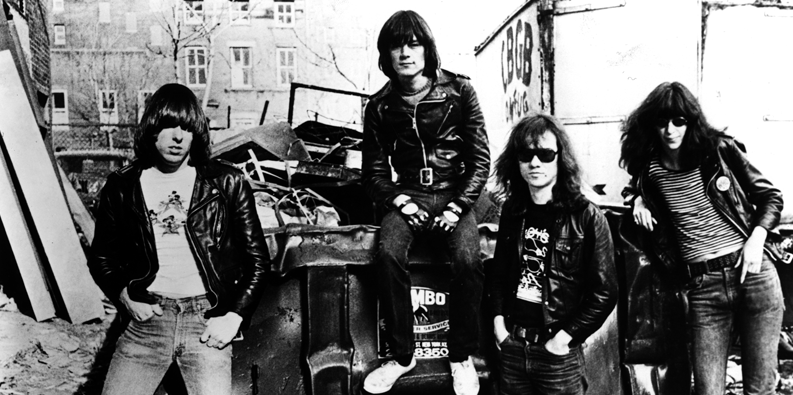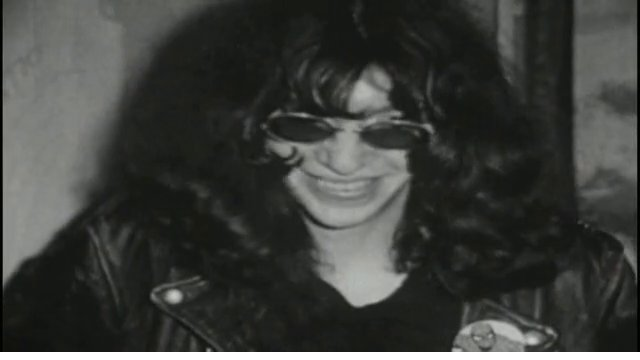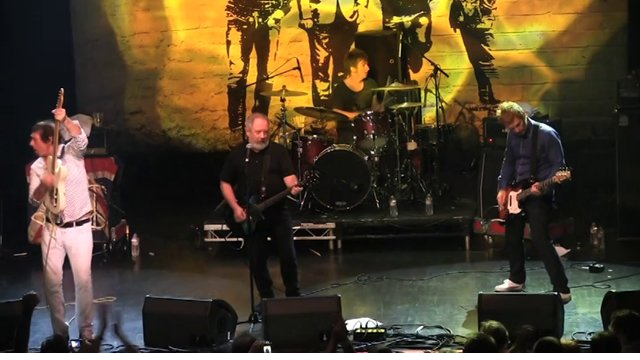Ramones Live At WFUV And At Queens Museum – always but especially this week at WFUV…til July 31, 2016 at Queens Museum
This week WFUV is celebrating the Ramones as an essential artist. I’ll be doing a 30 minute set of their music on the air at 90.7 FM NYC and WFUV.org from about 2 to 2:30.
New York City had bottomed out. Gerald Ford told us to drop dead. White flight was at its height. The time was the mid 70s and the neighborhood was Forest Hills in Queens. Beat On The Brat was coming out of the garage.
John William Cummings who became known to the world as Johnny Ramone was pursuing a life of delinquency with some enthusiasm. He was a Yankees fan living in the borough of The Mets. It’s safe to assume the attraction was pissing people off. He was smart and he played guitar and a vision for a band was beginning to coalesce in his mind. It involved a sound and a look and an attitude. His machine gun down-strokes and power chords suggested a profound disgust with Emerson, Lake, and Palmer. A four foot statue of his likeness now sits upon a two foot base in Hollywood Forever Cemetery. Joey Ramone came into the world as Jeffrey Ross Hyman. He had a serious case of OCD and combined being painfully shy with being uncomfortably tall. He was the object of some derision and perhaps not unlike the cartoon character he inspired.
Joey Ramone came into the world as Jeffrey Ross Hyman. He had a serious case of OCD and combined being painfully shy with being uncomfortably tall. He was the object of some derision and perhaps not unlike the cartoon character he inspired.
However, and here come two understatements, he could sing and when he stepped onto a stage, he was transformed. He became the voice of American punk. He raged. He crooned. He owned every word from the bored to the giddy to the angry to the brokenhearted. He wrote Sheena Is a Punk Rocker. He sang great in the studio but was better, as his band was, live. Joey Ramone Place is the most stolen street sign in the city according to the NYPD.
Douglas Glenn Colvin was a military kid and moved to Forest Hills from Berlin at the age of 15. Eight years later, he would adopt the monikerDee Dee Ramone. He sang and played the bass but struggled to do both at the same time. It was Dee Dee, the high school dropout, who would be their most essential songwriter. D – U – M – B¦everyone’s accusin’ me! The Ramones without him is unthinkable. His energy raised the stakes in any room and doubled that on stage. He sought recreational drugs perhaps to quell some exquisite inner pain or to combat mental illness or he just liked them. He wrote 53rd& 3rd about a closet case turning a trick as a male prostitute at the titular intersection in Manhattan. He also hitched us a ride to Rockaway Beach. He came up with the name Ramones. He was the one counting off: 1, 2, 3, 4!
Thomas Erdelyi was savvy enough as a teenager to get himself a job as an assistant engineer at The Record Plant on 44th Street in Manhattan. He got the idea of The Ramones and initially was the manager. He showed potential drummers what they were looking for but no one could do it like him. He became Tommy Ramone. He wrote Blitzkrieg Bop. He produced. While they were Johnny’s band everywhere else, in the studio they were Tommy’s band. He produced Tim for The Replacements who, of course and like so many others, couldn’t have existed without the former Forest Hills High Schoolers. Tommy was the last of the original quartet to die, two years ago in 2014 after Joey in 2001, Dee Dee in 2002, and Johnny in 2004.
The Bowery was skid row and The Ramones could get gigs at a joint named CBGB where bikers hung out. Arturo Vega heard what future manager Danny Fields and Robert Christgau from the Village Voice and Seymour Stein at Sire heard. Vega became a benefactor and his loft on East Second Street became a home-base. He then became logo designer and lighting director and very likely the only thing that kept them together for twenty-two years. His t-shirt turned on more people to the band than any media ever did. He attended every show but two in over 2200 Ramones performances.
Life on the road was not for Tommy so after playing drums on the first three records, he left the group in 1978. This was the end of the most significant era when The Ramones invented punk. It goes without saying it wasn’t in a vacuum. The Stooges united them. Five boroughs forebears The New York Dolls, The Velvet Underground and Lou Reed, and The Heartbreakers were essential. It seemed for a minute at the beginning that the band would break through on the radio but then The Sex Pistols came along and gave punk a bad name. Beating on the brat with a baseball bat wasn’t necessarily something a sheepish PD wanted to be associated with anyway.
They somehow never got a moment like the Grateful Dead got with Touch of Grey. The eleven albums that followed, ending with Adios Amigosin 1995, added quantity to the body of work but the blueprint didn’t change. The time signature wasn’t about to shift from 4/4. Their pop side that was always present may have been intermittently pushed to the front in an always futile attempt to sell more records. Imagine Phil Spector produced one for them, 1980’s End of the Century, and they still didn’t make significant progress commercially.
Johnny and Joey were not natural allies. If conflict is the engine of creativity and innovation and drama, it was their relationship that defined the group and supplied the angst crucial to voicing angst. Johnny was the group’s disciplinarian and general in what more than a few observers recalled as a military like organization. Even his allies characterized him as controlling. Joey, universally described as sweet, may be the most loved NYC musical personality.= He appeared at a campaign event for Jerry Brown while Johnny was a Reagan man and a Bush man and even another Bush man.
When Johnny stole Joey’s girl (Linda Daniele) and then they married making her Linda Ramone, it would have killed 99 bands out of 100. The Ramones were the 100th. They shared a name. Through Marky (drums from ’78 to ’83 & ’87 to the end in ’96) and Richie (drums ’83 to ’87) and even Elvis (better known as Clem Burke who sat in for a handful of shows) and C.J. (bass ’89 to ’96 after Dee Dee left) the marriage of Joey and Johnny through every bus ride and every club and motel room, and long after they stopped talking to each other, endured.
As their music has endured. Just as it immediately became part of the DNA of The Clash, it somewhere along the line became part of the DNA of New York. Sometime after that it became part of the DNA of American music. It’s obviously part of the DNA of WFUV. The Ramones are this week’s essential artist. Hey! Ho! Let’s Go Ramones and The Birth of Punk, a dynamite exhibit at the Queens Museum runs through the end of this month. It’s got the gig posters and album covers and comic books and clothing and instruments and other bric a brac. It will horrify you by reminding of Dee Dee’s career as a hip hop artist as well.



